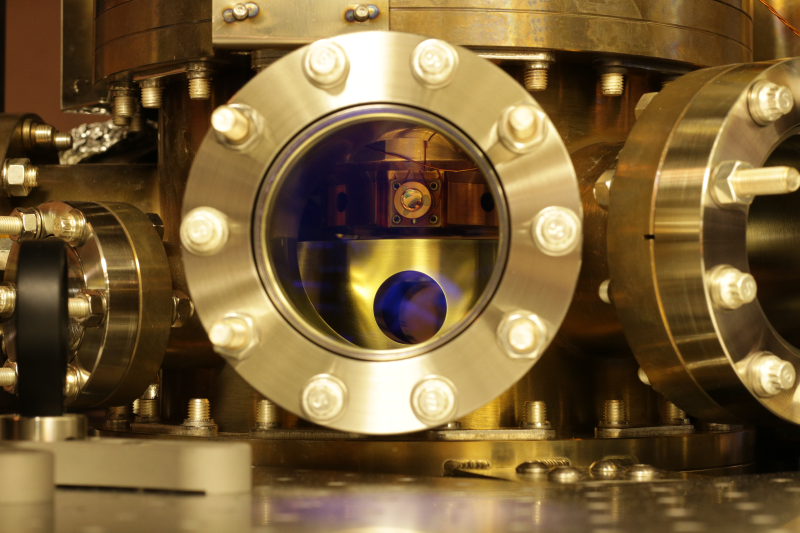Groundbreaking new atomic clock detects dark matter and gravity’s effect on time
MIT physicists have developed a quantum entangled atomic clock that achieves precision four times faster than current models, potentially unlocking new insights into the nature of time and the universe.

MIT physicists create a quantum entangled atomic clock with four times more precision, opening doors to dark matter detection and time exploration.
Excerpt: MIT physicists have developed a quantum entangled atomic clock. (CREDIT: CC BY-SA 3.0)
Atomic clocks represent the pinnacle of precision in timekeeping. Using lasers, these instruments measure the steady vibrations of atoms, which oscillate at constant frequencies. To put their accuracy into perspective, if one of the world's best atomic clocks had been running since the beginning of the universe, it would only be off by about half a second today.
But even these highly accurate clocks can be improved. Enhancing their ability to measure atomic vibrations could lead to breakthroughs, such as detecting elusive phenomena like dark matter or gravitational waves. This improvement might also help answer profound questions about the nature of time itself, including whether time changes as the universe evolves or how gravity influences the flow of time.
A new atomic clock developed by physicists at MIT could pave the way to these advancements. As reported in Nature, this novel clock doesn't rely on measuring random oscillations of atoms like current state-of-the-art designs. Instead, the atoms in this clock are quantumly entangled, meaning they behave in a correlated manner that classical physics cannot explain. This entanglement allows for a more precise measurement of atomic vibrations, achieving greater accuracy faster than clocks without entanglement.
"Entanglement-enhanced optical atomic clocks will have the potential to reach a better precision in one second than current state-of-the-art optical clocks," says Edwin Pedrozo-Peñafiel, the lead author and a postdoc at MIT's Research Laboratory of Electronics.
If today’s top atomic clocks were upgraded with this quantum entanglement technique, their precision would increase to the point where, even after running for the entire age of the universe, they would be less than 100 milliseconds off.
Related Stories
Since humanity began tracking time, we’ve used periodic events, such as the sun’s movement across the sky. Today, the vibrations of atoms provide the most reliable periodic phenomena known to science. For instance, a single cesium atom will always oscillate at the same frequency as another cesium atom. Theoretically, the perfect clock would measure the oscillations of a single atom, but things get tricky at this scale.
Atoms follow the strange rules of quantum mechanics, where outcomes seem random. It's like flipping a coin; each flip is uncertain, but over many flips, the probability becomes clear. This randomness is a limitation called the Standard Quantum Limit. To get around this, modern atomic clocks don’t rely on just one atom but measure thousands of the same type of atom. By averaging their vibrations, clocks can provide an estimate of the frequency.
“When you increase the number of atoms, the average given by all these atoms goes toward something that gives the correct value,” explains MIT researcher Simone Colombo.
Atomic clocks work by first using lasers to cool a cloud of atoms and trap them. A second, highly stable laser, tuned to the same frequency as the atoms' vibrations, probes the oscillations to keep track of time. Yet, even when measuring thousands of atoms, there's still some uncertainty due to the Standard Quantum Limit. This is where quantum entanglement offers a significant advantage.
Quantum entanglement is a phenomenon where atoms in a group are so interconnected that measuring one affects the others. The team at MIT theorized that if atoms were entangled, their vibrations would align more closely around a common frequency, reducing the variation and increasing the clock’s accuracy beyond what is possible with non-entangled atoms.
To test this, the researchers built a clock that entangles around 350 atoms of ytterbium, an element that oscillates at the same high frequency as visible light. Ytterbium atoms vibrate 100,000 times more frequently than cesium atoms in a second, making them ideal for tracking time in finer increments.
In their setup, the team cooled the ytterbium atoms and trapped them in an optical cavity between two mirrors. A laser beam passed through the cavity, bouncing between the mirrors and interacting with the atoms thousands of times. This interaction created a communication link between the atoms.
"It’s like the light serves as a communication link between atoms," explains Chi Shu, a researcher on the team. The laser light modified each atom as it passed, causing the atoms to synchronize their behavior through many cycles.
Once the atoms were entangled, the researchers used another laser to measure their average frequency. When they compared this setup to one without entanglement, they found that the entangled atomic clock achieved its desired precision four times faster.
“You can always make the clock more accurate by measuring longer,” says team leader Vladan Vuletic, MIT’s Lester Wolfe Professor of Physics. “The question is, how long do you need to reach a certain precision? Many phenomena need to be measured on fast timescales.”
With this breakthrough, entangled atomic clocks could not only improve timekeeping but also open new avenues for exploring the universe. By detecting minuscule signals, they could help scientists investigate dark matter, gravitational waves, and long-standing mysteries about the fundamental laws of physics.
"As the universe ages, does the speed of light change? Does the charge of the electron change?" Vuletic asks. "That’s what you can probe with more precise atomic clocks."
This work has the potential to revolutionize how we measure time and understand the universe. With support from organizations like DARPA, the National Science Foundation, and the Office of Naval Research, these findings may lead to discoveries that reshape our grasp of time, matter, and space.
Note: Materials provided above by The Brighter Side of News. Content may be edited for style and length.
Like these kind of feel good stories? Get The Brighter Side of News' newsletter.



